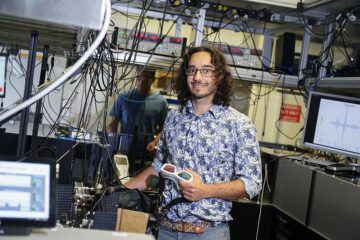The origin of the brain lies in a worm

The rise of the central nervous system (CNS) in animal evolution has puzzled scientists for centuries. Vertebrates, insects and worms evolved from the same ancestor, but their CNSs are different and were thought to have evolved only after their lineages had split during evolution. Researchers from the European Molecular Biology Laboratory (EMBL) in Heidelberg now reveal that the vertebrate nervous system is probably much older than expected. The study, which is published in the current issue of Cell, suggests that the last common ancestor of vertebrates, insects and worms already had a centralised nervous system resembling that of vertebrates today.
Many animals have evolved complex nervous systems throughout the course of evolution, but their architectures can differ substantially between species. While vertebrates have a CNS in the shape of a spinal cord running along their backs, insects and annelid worms like the earthworm have a rope-ladder-like chain of nerve cell clusters on their belly side. Other invertebrates on the other hand have their nerve cells distributed diffusely over their body. Yet, all these species descend from a common ancestor called Urbilateria. If this ancestor already possessed a nervous system, what it might have looked like and how it gave rise to the diversity of nervous systems seen in animals today is what Detlev Arendt and his group study at EMBL. To do so, they investigate the nervous system of a marine annelid worm called Platynereis dumerilii.
“Platynereis can be considered a living fossil,” says Arendt, “it still lives in the same environment as the last common ancestors used to and has preserved many ancestral features, including a prototype invertebrate CNS.”
Arendt and his group investigated how the developing CNS in Platynereis embryos gets subdivided into the regions that later on give rise to the different CNS structures. The regions are defined by the unique combination of regulatory genes expressed, which endow every type of neuron with a specific molecular fingerprint. Comparing the molecular fingerpint of Platynereis nerve cells with what is known about vertebrates revealed surprising similarities.
“Our findings were overwhelming,” says Alexandru Denes, who carried out the research in Arendt’s lab. “The molecular anatomy of the developing CNS turned out to be virtually the same in vertebrates and Platynereis. Corresponding regions give rise to neuron types with similar molecular fingerprints and these neurons also go on to form the same neural structures in annelid worm and vertebrate.”
“Such a complex arrangement caould not have been invented twice throughout evolution, it must be the same system,” adds Gáspár Jékely, a researcher from Arendt’s lab, who contributed essentially to the study. “It looks like Platynereis and vertebrates have inherited the organisation of their CNS from their remote common ancestors.”
The findings provide strong evidence for a theory that was first put forward by zoologist Anton Dohrn in 1875. It states that vertebrate and annelid CNS are of common descent and vertebrates have turned themselves upside down throughout the course of evolution.
“This explains perfectly why we find the same centralised CNS on the backside of vertebrates and the bellyside of Platynereis,” Arendt says. “How the inversion occurred and how other invertebrates have modified the ancestral CNS throughout evolution are the next exciting questions for evolutionary biologists.”
Media Contact
Weitere Informationen:
http://www.embl.de http://www.embl.org/aboutus/news/press/2007/20apr07/index.htmlAlle Nachrichten aus der Kategorie: Biowissenschaften Chemie
Der innovations-report bietet im Bereich der "Life Sciences" Berichte und Artikel über Anwendungen und wissenschaftliche Erkenntnisse der modernen Biologie, der Chemie und der Humanmedizin.
Unter anderem finden Sie Wissenswertes aus den Teilbereichen: Bakteriologie, Biochemie, Bionik, Bioinformatik, Biophysik, Biotechnologie, Genetik, Geobotanik, Humanbiologie, Meeresbiologie, Mikrobiologie, Molekularbiologie, Zellbiologie, Zoologie, Bioanorganische Chemie, Mikrochemie und Umweltchemie.
Neueste Beiträge

Neue universelle lichtbasierte Technik zur Kontrolle der Talpolarisation
Ein internationales Forscherteam berichtet in Nature über eine neue Methode, mit der zum ersten Mal die Talpolarisation in zentrosymmetrischen Bulk-Materialien auf eine nicht materialspezifische Weise erreicht wird. Diese „universelle Technik“…

Tumorzellen hebeln das Immunsystem früh aus
Neu entdeckter Mechanismus könnte Krebs-Immuntherapien deutlich verbessern. Tumore verhindern aktiv, dass sich Immunantworten durch sogenannte zytotoxische T-Zellen bilden, die den Krebs bekämpfen könnten. Wie das genau geschieht, beschreiben jetzt erstmals…

Immunzellen in den Startlöchern: „Allzeit bereit“ ist harte Arbeit
Wenn Krankheitserreger in den Körper eindringen, muss das Immunsystem sofort reagieren und eine Infektion verhindern oder eindämmen. Doch wie halten sich unsere Abwehrzellen bereit, wenn kein Angreifer in Sicht ist?…





















